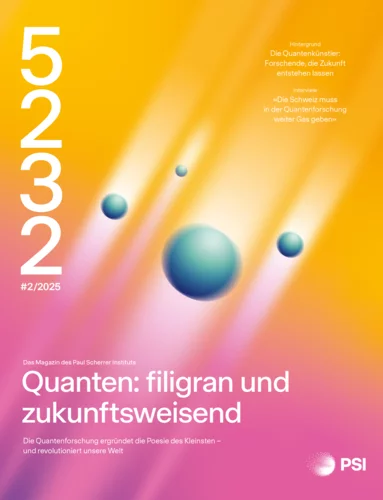Budget
Der Finanzierungsbeitrag des Bundes an das PSI für Forschung, Lehre und den Betrieb der Grossforschungsanlagen betrug 2024 rund 300 Mio. CHF bei einem jährlichen Gesamtertrag von ca. 450 Mio. CHF.
Die gesamten Erträge des PSI für die Forschung und Lehre setzen sich wie folgt zusammen (in Mio. Franken):
| Erträge für Forschung, Lehre und Betrieb der Grossforschungsanlagen | Mio. CHF |
| Aus Trägerfinanzierung * | 302.0 |
| Schulgelder und andere Benutzungsgebühren | 2.7 |
| Forschungsbeiträge, -aufträge und wissenschaftliche Dienstleistungen | |
| – davon wirtschaftsorientierte Forschung (Privatwirtschaft) | 12.8 |
| – davon SNF, KTI, Ressortforschung Bund | 34.8 |
| – davon EU-Programme | 6.9 |
| – davon übrige projektorientierte Drittmittel | 17.8 |
| Schenkungen und Legate | 1.1 |
| Übrige Erträge | 66.9 |
| Kennzahlen zu Aufwand und Investitionen | |
| Personalaufwand | 291.0 |
| Sachaufwand | 123.9 |
| Investitionen in Sachanlagen | 67.0 |
* ohne Beitrag an die Unterbringung
Weitergehende Finanzinformationen finden Sie in unserem Geschäftsbericht.
Personal
Das PSI hatte Ende 2024 rund 2'300 Mitarbeitende. Davon war ein Viertel Postdocs, Doktorierende und Lernende. Insgesamt sind 38 % der Stellen mit wissenschaftlichem Personal besetzt. 53 % der Mitarbeitenden führen technische oder Ingenieurstätigkeiten aus. Mit ihren vielfältigen Kompetenzen sorgen sie dafür, dass die vorhandenen wissenschaftlichen Anlagen des Instituts stets zuverlässig funktionieren und neue plangemäss aufgebaut werden. Damit haben sie wesentlich Anteil an den wissenschaftlichen Leistungen des Instituts. 8 % der Stellen sind der Administration zugeordnet. 27 % der Mitarbeitenden sind Frauen, 55 % sind ausländische Staatsbürger.
Lehre und Doktorandenbetreuung
2024 forschten mehr als 350 Doktorierende am PSI an ihrer Promotionsarbeit, davon waren mehr als 250 am Institut angestellt. Ihre Grundausbildung haben die jungen Forschenden vor allem in Physik, Chemie und den Ingenieurwissenschaften absolviert. Die meisten an den ETH Zürich und Lausanne, den Universitäten Zürich und Bern sowie im Ausland. Die Forscher am PSI engagieren sich jedoch nicht nur vor Ort in Villigen bei der Ausbildung von Studierenden. Etwa 300 PSI-Wissenschaftlerinnen und -Wissenschaftler unterrichten an einer Schweizer Hochschule oder Fachhochschule. Das Engagement an den Hochschulen übernehmen die PSI-Wissenschaftler dabei oftmals unentgeltlich, sodass für die Hochschulen ein doppelter Mehrwert generiert wird: Sie können ihren Studierenden Zugang zu Spitzenforschung an Grossforschungsanlagen bieten, die eine Universität so nicht betreiben kann. Gleichzeitig können sie ihre Lehre kostengünstiger anbieten.
Benutzerlabor und internationale Vernetzung
Das PSI leistet als nationales Benutzerlabor für die Forschenden aus Hochschulen und Industrie wesentliche Beiträge. Dabei fliessen etwa zwei Drittel des Gesamtbudgets anteilsmässig in Betrieb, Unterhalt und Weiterentwicklung der Forschungseinrichtungen sowie in die Betreuung und Unterstützung der Forschenden der Schweizer Hochschulen. An seinen Grossforschungseinrichtungen betreute das Institut im Jahr 2024 circa 2'100 Wissenschaftlerinnen und Wissenschaftler aus der Schweiz und dem Ausland.
Der Erfolg eines Benutzerzentrums zeigt sich vor allem im Interesse der Forschergemeinde, dort Experimente durchzuführen, sowie in der Zahl von Veröffentlichungen, die auf den durchgeführten Experimenten beruhen.
So erschienen 2024 rund 750 Fachartikel, die auf Experimenten an den Grossforschungsanlagen des PSI beruhen. Jedes Jahr verzeichnet das PSI etwa 3'500 Besuche von Wissenschaftlern aus der ganzen Welt, die an rund 40 Messplätzen ihre Experimente durchführen. Die meisten Nutzer kommen aus der Schweiz und den Ländern der EU. Die Schweizer Experimentatoren teilen sich wiederum etwa gleichmässig auf das PSI und andere Einrichtungen auf, wobei die meisten externen Forscher von der ETH Zürich kommen. Regelmässig vertreten sind aber auch die ETH Lausanne, die Universitäten und die EMPA.
| Statistik für das Jahr 2024 | ||||||
|---|---|---|---|---|---|---|
| PSI Anlage | Synchrotron Lichtquelle Schweiz SLS * | SwissFEL | Schweizer Spallations-Neutronenquelle SINQ | Schweizer Myonen Quelle SμS | CHRISP | Gesamt 2024 |
| Anzahl Besuche Gastwissenschaftler | 0 | 234 | 660 | 206 | 860 | 1'960 |
| Anzahl Experimente | 0 | 28 | 426 | 240 | 13 | 707 |
* Die Synchrotron Lichtquelle Schweiz SLS wurde upgegradet, weswegen 2024 keine Experimente durchgeführt werden konnten.
Protonentherapie – unmittelbarer Profit für die Gesellschaft
Direkt und unmittelbar profitieren Teile der Gesellschaft vom Protonentherapie-Ambulatorium des Instituts. Im Jahr 2024 wurden rund 5'500 Bestrahlungs-Fraktionen an Krebspatienten verabreicht und das Zentrum für Protonentherapie am PSI registrierte rund 1'800 ärztliche Konsultationen. Mit einer Erfolgsrate von über 98 % steht das PSI international an vorderster Front bei der erfolgreichen Bestrahlung von Augenmelanomen. Von den Patienten mit tief liegenden Tumoren, die an der Gantry behandelt wurden, waren 2024 circa 30 % Kinder und Jugendliche. Knapp die Hälfte davon waren Kleinkinder, die unter Narkose behandelt wurden. Zwei Bestrahlungsstationen (Gantry 2 und Gantry 3) für tief im Körper liegende Tumore sowie eine Bestrahlungsstation (OPTIS2) für Augentumore stehen für die Patientenbehandlung zur Verfügung.
ETH-Bereich
Das Paul Scherrer Institut PSI gehört zum ETH-Bereich.
Weitere Mitglieder sind: ETH Zürich | EPF Lausanne | EMPA | WSL | Eawag

